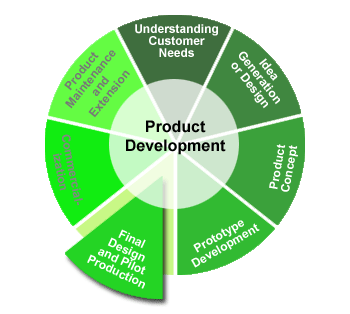

|
Design and Product Development |
Copyright 2006
Cornell
University.
All rights reserved.
|
View materials specification sheet here A picture of the product with the sewing operations, stitch types, and seam allowances is needed for the production department and sewing machine operators. The exact dimensions of the finished product and the acceptable tolerances (e.g., a seam allowance can be +/- 1/8" off) can help in quality assurance. A sample production specification sheet is shown below.
The commercialization matrix
Optimizing your product for production focuses primarily on the first three items: production method, cost, and volume.
The prototype patterns and construction methods often need to be modified by
If you choose custom production, you will make individually designed and produced products. Your prototype may not need changes before commercialization, i.e., you may make only one final product. Your profit will come from high price rather than high volume. The objective of mass production is to make the production process cost effective by
Modifying the prototype to accommodate volume and cost requirements is very important in a mass production setup. It requires standardizing and simplifying the pattern pieces, seam allowances, and seam types. Mass customization is a relatively new business strategy that adds value as well as reduces the cost of the product by
This unique approach requires technologies that can produce small numbers of similar products at a low cost. The production cost may be higher than mass production due to individualized design and small production lots. But the cost is lower than custom due to extensive technology use. Making products to order instead of as stock items, reduced inventory cost of finished goods to zero. Profitability depends on getting enough orders at a price that will pay for the technology and individual service. Cost and pricing There are several approaches to pricing that you should consider. Cost-based pricing starts with how much it costs to produce one unit or piece. The direct costs include materials, labor, and marketing. An overhead cost is calculated based on an annual rate for all design and production. This includes rent, lights, heat, and travel to trade shows, for example. The overhead cost can be calculated for each product unit as a percentage of the direct costs or as a dollar amount and added directly to the unit cost. The final variable is profit. Direct Cost + Overhead (% of direct cost) + profit = Cost-based Price Overhead percentages vary widely based on a business's expenses. If you work out of your home, your overhead would be much lower than if you run a factory with 25 workers and extensive equipment. Direct costs might be high if you contracted out all of your production, but your overhead would be lower. Profit percentages vary dramatically based on the market, product innovation, and the prestige of a product. Demand-based pricing calculates prices based on
For example, you set the price based directly on competitors' prices. Market penetration pricing is used to enter a new market, setting prices lower than competitors' products in order to gain some of their market share. If you want to establish a product as a prestige item based on its uniqueness, high fashion, or quality materials, you may want to use status pricing. It assumes customers will pay more than the cost of a product warrants because of its value to them. This strategy can lead customers to think your product cost more for production than it actually did and purchase it for that price. This results in a higher profit for your product. The risk is that customers will not buy the product at all because they think it is overpriced. The potential for market success and profit needs to be considered before you start production. Only those products that have the potential to sell in high enough volume to make profit should be commercialized.
|
|||||||||||||||||||||||
 Optimizing product design for production
Optimizing product design for production